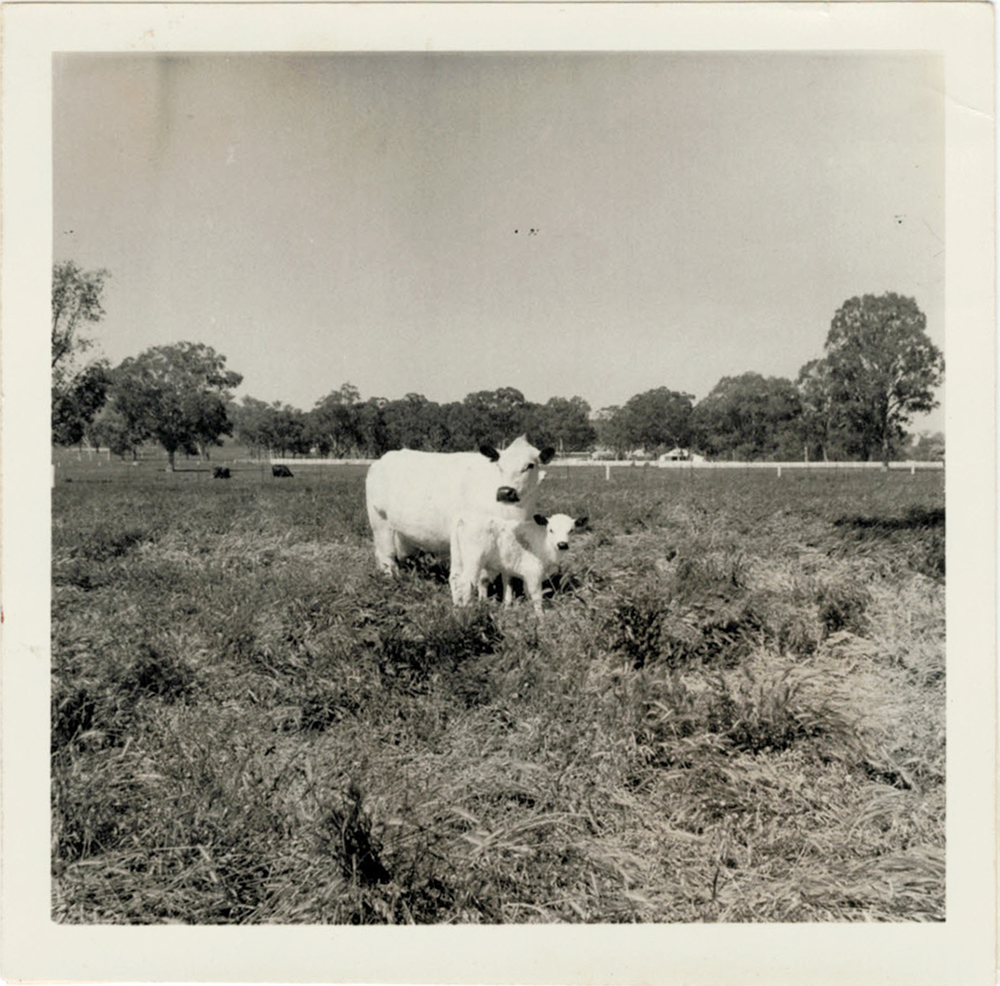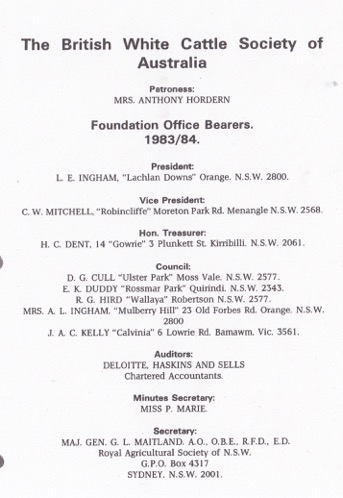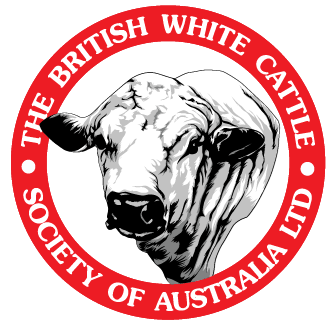The Breed and The Societies History
The BreedAn Ancient Past
The modern day breed of cattle known as British Whites can claim direct links with the ancient indigenous wild white cattle of Great Britain, notably from the park at Whalley Abbey, Lancashire which was bought by Richard Assheton in 1553. In 1697 Ralph Assheton of Middleton Hall near Manchester inherited Whalley and in 1765 Mary Assheton, heiress to Middleton, married Sir Harbord Harbord (Lord Suffield) of Gunton Hall in Norfolk and brought with her some of the white polled cattle from her former home, which were reputed to have originated from Whalley Abbey.
The Gunton Park cattle were the foundation of at least two herds of note, firstly through Lord Suffleld’s daughter-in-law Lady Caroline Harbord who succeeded to Blickling near Aylsham, Norfolk in 1793 and although the exact date of the arrival of the Gunton Cattle at Blickling is unknown it was between 1793 and 1812. These became almost extinct from cattle plague about 1860, with only two individuals remaining, but from these the herd was built up again and survived to help in the foundation of many other herds and the Park Cattle Society itself in 1918.
The second herd founded from Gunton stock was that at Woodbastwick, established in 1840 by the purchase of one or two animals at a sale held by the fourth Lord Suffield. For many years the red pointed animals were preferred at Woodbastwick and black pointed calves were transferred to Blicking, vice versa the red pointed calves. However, by 1918 the universally dominant colour was black pointed, red points occurring at a similar low level of frequency as today.
As can be clearly seen, the breeders of these cattle were engaged in a continual struggle to maintain numbers, and from time to time the blood of other breeds was introduced in order to avoid problems associated with in-breeding and to achieve the desired type. (The article on page 7 of the 1998 British White Breed Journal by Mr J Cator gives a full account of these outside sources used between 1840 and 1918 in the Woodbastwick herd).
Another herd which contributed much to the early development of the breed was the Somerford herd of Sir Walter Shakerley, Bart., Somerford Park, Cheshire. Unfortunately, no record of the origin of this herd exists, but it was described as being intermediate in type between the Horned and Polled park cattle. The Shakerley family originated from a place of the same name close to Middleton (from which come the Norfolk herds), but Somerford is only fifteen miles from Lyme and thirty from Chartley (both homes of ancient horned herds) and reference was made to the similarity between the two. Indeed horned animals were not uncommon in the Somerford herd and have had a considerable influence in the White Park (horned) breed. (See Vol XII The Park Cattle Society’s Herd Book).
Between 1875 and 1918 general exchanges of bulls took place between Somerford and the herds at Woodbastwick and Northrepps (founded about 1890 with a bull from Woodbastwick and a cow from Blickling), thus the blood of all these founding herds was commingled. Beside those already mentioned there were another three polled herds existing at the time of the foundation of Park Cattle Society in 1918. The herd at Bawdeswell was one of the largest, and was an offshoot from the Northrepps herd which was divided between members of the Gurney family in 1912.
The Kelmarsh herd was founded in 1903 by animals brought from the Blickling herd on which bulls from the other polled herds were used.
The Faygate herd founded in 1908 were at first mainly of horned derivation, but by 1918 been divided into two, Horned and Polled, the polled section based on cows from Northrepps and Kelmarsh, with a Kelmarsh bull.
By the beginning of the twentieth Century there was an awareness that the outstanding and unique qualities of “Park Cattle” could best be conserved and promoted by the banding together of breeders. Sir Claud Alexander owner of the Faygate herd, writing in the Amateur Menagerie Club Year Book 1912 says “I would, however, strongly advise anyone who may think of forming a herd to go to the Polled variety for his foundation stock, for they have been kept from time immemorial for their milk and beef producing qualities, and right well do they justify their existence…. The Somerford cows are excellent milkers and one of mine averages five gallons a day when in full profit. In addition to this they are big heavy beasts and give a good return from the butcher when their milking days are over. Mr Quinton Gurney’s herd at Northrepps Hall is a thoroughly practical one, for on it devolves the task of keeping the town of Cromer supplied with milk. At Woodbastwick too some grand milkers are to be found, and here great attention is paid to beef producing powers, as the records of the local fat stock shows frequently testify. If anyone who reads these notes and feels inclined to form a herd will communicate with me, I shall be pleased to supply any information that may be required”.
And so, shortly afterwards in January 1918 the Park Cattle Society was formed “with the object of keeping records of Park Cattle, wild and tame, of developing and popularising their great commercial qualities as well as keeping up developing scientific interest in this most ancient race”. It should be a matter of some pride and satisfaction to all members of the British White Cattle Society of today that we are still maintaining exactly the same aims as those the Society was formed on. (Thankfully with considerable success over the years). The first Volume of the Park Cattle Society’s Herd Book was published in 1919, and it is interesting to note that the constitution and rules of the Society remain materially unaltered to the present day. In Volume III (1922), the first breed standard was published in which it is stated “Park Cattle shall be large and massive, dual-purpose, cattle of symmetrical appearance”, also “length of legs – medium, in proportion to the size of the animal the legs should be such as to avoid any semblance to an appearance of “shortness” or “longness” of leg length.
In the early years of the Society (up to 31 December 1940) the registration of Park Cattle took two forms, firstly animals certified by the owners of any established herd to be without cross of any other breed were issued with a pedigree number,(indicating the view of the Society that where outside blood had been used in the past it was accepted that its influence was now so diffuse that it would not prevent the animal from breeding true to type) and secondly cattle which were partly of registered blood could be registered on inspection, provided they were, in the opinion of the inspectors, eligible according to standard. These entries were given a pedigree number followed by the letters IFS. In addition a grading up register was started in 1928 allowing breeders to register half bred animals at section A (first cross) to become eligible for pedigree registration at the fifth cross or generation of pedigree blood. With careful selection for type and colour, and no doubt strengthened by the inclusion of wider blood lines the breed swiftly re-established a strong distinct and predictable type.
In 1946 the two forms of Park Cattle, Horned and Polled decided to split and administer their own affairs, and thus the British White Cattle Society evolved.
Dual Purpose Qualities
Great notice is taken in the earlier herd books of the milking properties of the cattle. Most of the polled herds were at that time commercially milked and detailed records are given of both herd and individual performance, often with notable successes in competition with other breeds. The earliest mention (Vol IV) is of the success of Messrs. Buxton and Birkbeck in winning the Norfolk milk recording Society’s small herds competition with an average yield of 10,616 lbs. per cow for five park (polled) cattle in competition with all other breeds.
In Vol VI the Woodbastwick bred heifer Faygate Laura is said to have given 10,160 lbs in 327 days with her first calf and 12,603 lbs in a year with her second, Whilst in Vol IX special mention is made of Bawdeswell Catmint, who gave 13,876 lbs in 326 days and obtained a certificate of merit with a yield of 35,928 lbs in 3 years. The fact that milk records were included in the herd books reflects the importance placed upon the excellent dairy properties of the cattle by the pioneer breeders. The ability to milk heavily is one of the qualities which sets our breed apart from those it competes with in the commercial arena today.
Alongside the obvious attention paid to the milking ability of the breed is the esteem in which its beefing qualities were held by the early breeders. Beginning in vol XIII, the results of the Norfolk and Norwich fat cattle show are included in some of the early herdbooks and they provide ample evidence of the excellence of the breed in the arena.
Jumble, a steer owned and bred by the Cator family, was first and best of all breeds at Norwich fat-stock show in 1931. Aged 2 years 5 months and 6 days and weighing 13 cwts 1 qtr and 10lbs (679kgs), he sold for £45:10 shillings, the highest price per cwt of any animal in the show. In 1934 the 2nd prize-winner, Crescent, owned by Major Q.E. Gurney of Bawdeswell weighted 15 cwts 2 qtr 1 lb (789 kgs) at 2 years and 10 months.
British White Cattle Overseas
The first instance of the export of British White Cattle recorded in the herd book is that of the bull Woodbastwick Jason 411 exported to Columbia in 1928. Between 1949 and 1951 2 bulls and 6 females were shipped to Brazil from the Bawdeswell, Bolwick and Hevingham herds and in 1956 the bull Bawdeswell Nordic 1247 went to Kenya. It is, however, in Australia and the USA that the breed has taken the firmest grip, both countries having their own breed societies with a considerable number of registrations.
There is some evidence that British Whites may have been introduced to the United States in the 18th Century by English immigrants, but what is certain is the in 1941, in the face of a threatened German invasion of Britain, five cows and one bull were shipped to Pennsylvania on the orders, it is said, of Winston Churchill. These animals, with the addition of several bulls subsequently exported from England, form the foundation of today’s British White herds in America.
The first exportation to Australia consisted of three in-calf heifers from the Woodbastwick herd in 1958.
Key Dates in British White History.
The British White breed has a long and ancient history which, if not recorded for the whole of the past millennium, at least covers almost half of it. Here are some of the most important events, listed chronologically showing the path which has led our breed from the 16th to the 21st century.
1553 – Richard Assheton acquires Whalley Abbey, Lancashire which reputedly had a herd of British White Polled cattle in the Lords Park.
1697 – Ralph Assheton of Middleton Hall, near Manchester inherits Whalley.
1700 – The herd at Middleton described by Dr Charles Leigh as ‘wild cattel’.
1765 – Ralph Assheton dies and his eldest daughter, Mary, marries Sir Harbord Harbord of Gunton Hall, Norfolk, bringing with her part of the herd from Middleton.
1793 – Lady Caroline Harbord succeeds to Blickling, Norfolk.
1840 – Woodbastwick herd founded by Albermarle Cator with one or two animals from Gunton.
1853 – Gunton herd becomes extinct.
1860 – Blickling herd reduced to two or three animals by ‘cattle plague’. From these and other sources, including Woodbastwick, the herd was rebuilt.
1875 – Rev John Storer, author of ‘The Wild White Cattle of Great Britain’, visits Somerford Park, Cheshire and records a herd of 20 head.
1882 – ‘Occasional’ or ‘Constant’ exchanges of bulls takes place between Somerford and Woodbastwick herds.
1890 – Northrepps herd founded by RHJ Gurney with a bull from Woodbastwick and females from Blickling.
1903 – Kelmarsh herd founded with Blickling stock.
1908 – Faygate herd established with ‘cattle from all available sources’.
1912 – Bawdswell herd established by Major Q E Gurney, by dividing the herd at Northrepps.
1918 – Park Cattle Society founded, catering for both horned and polled cattle.
1919 – First Herd Book published, includes pedigree and part bred (IFS) animals.
1920 – Bolwick herd (forerunner of the Hevingham herd) founded with females from Bawdswell and Northrepps.
1923 – Blickling herd dispersed.
1925 – Somerford herd dispersed, having existed for ‘well over 200 years’.
1928 – Commencement of the Grading Up Register.
1928 – British White bull exported to Columbia.
1941 – British Whites sent to USA in face of the threatened German invasion.
1946 – British White Cattle Society evolves from the Park Cattle Society, administering the affairs of the polled herds only.
1949 – British Whites exported to Brazil.
1956 – British Whites exported to Kenya.
1957 – British Whites exported to Australia.
1963 – Numbers fall to dangerously low levels, only 14 pedigree females and 1 bull born in 1963 are registered.
1973 – Rare Breeds Survival Trust formed.
1996 – British White Cattle Society commences closure of the G.U.R.
1990 to 1999 – Calf registrations exceed 400 annually.
Sourced from BWCS (UK) Journal 2000 p4-5

Woodbastwick Belita, Berry and Willow Wench Imported by Hordern Feb 1958

Cow and Calf on the Hordens property in NSW
The Australian Story
British White cattle first appeared in Australia in 1958 with the importation by Mrs Anthony Hordern of three purebred heifers from the Woodbastwick herd in Norfolk. She developed the herd to a high level first at “Round Hill”, Culcairn and then at “Gledswood”, Catherine Fields, NSW before dispersing it in 1971.
From this dispersal a number of herds and breeding programs developed and it soon became evident that a Society was essential to further develop the breed in this country.
Formation of The Society
The British White Cattle Society of Australia was formed following an inaugural meeting of breeders and other interested persons held at the Royal Agricultural Society Show Grounds in Randwick.
The meeting was on the 6th April 1982 and chaired by Mr Anthony Hordern. A committee was elected to draw up a Constitution and Regulations to meet the needs of the nascent society, and to initiate the long and exacting task of inspecting herds and breeder records in order to compile a foundation Herd Book.
Significant support for the undertaking was provided by the Royal Agricultural Society of NSW, the British White Cattle Society (UK) and the White Park Cattle Association of America.
Herd Book
After official inspection and approval on type and conformation a foundation Herd Book was published in December 1985 after official inspection of all potential animals.
The first Herd Book details of 34 British White bulls and 407 British White females.
The bulls consisted of 12 “A” class (pure imported bloodlines) and 22 “Foundation A” class.
The females comprised two “A” class, 143 “Foundation A”, 97 “Foundation B”, 43 “Foundation C” and 121 “Foundation D” and one “Foundation E”.


